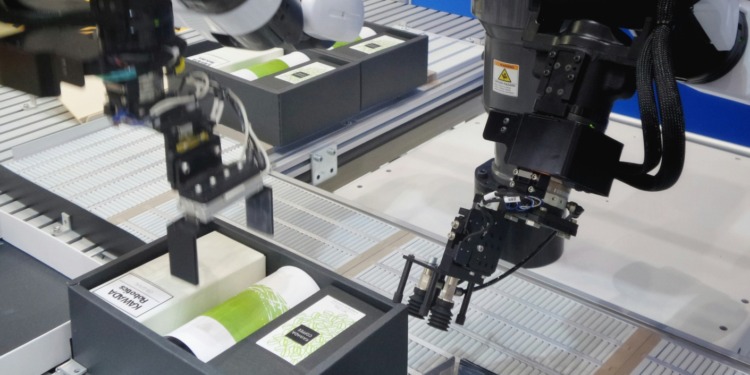Gone are the days of manual labour and repetitive tasks. Nowadays, automated robots are seamlessly taking over these responsibilities, leaving human workers to focus on complex problem-solving and innovation. These robots are equipped with advanced sensors, artificial intelligence (AI), and machine learning capabilities, allowing them to adapt to changing conditions, troubleshoot issues, and optimize operations in real time.
German startup RobCo, for example, offers flexible, cost-effective, and interconnected complete robot automation solutions for repetitive manual tasks in small and medium-sized industrial businesses.
Their technology is built on their patented modular hardware kit and RobCo Studio software platform. They have created software, based on the findings from the robotics department at TU Munich, that allows the modules to comprehend their current configuration and the specific application they are being used for.
The startup, established in 2020 by Roman Hölzl, an individual recognised in Forbes’ 30 Under 30 list, recently secured funding of $43 million. Led by Lightspeed Venture Partners, this investment aims to support the growth of RobCo and advance the development of artificial intelligence.
The focus is on creating AI technologies that enhance the intelligence of robots, enabling them to optimize work processes and successfully adapt to new environments through the use of basic commands.
In recent years, the use of automated robots in industries has changed many aspects of how businesses operate. With speed, accuracy, and dependability at the forefront, manufacturing processes have witnessed a surge in both productivity and output. Businesses of all sizes have the opportunity to enhance their production capabilities, maximize profitability, and maintain a competitive edge in the market.
Here are some notable examples:
- Italian startup HIRO Robotics has created the HIRO VS4, a cutting-edge vision guidance system designed specifically for industrial robotic arms. Instead of relying solely on images, this innovative system gathers video stream data, enabling it to achieve a much higher level of accuracy and efficiency.
- RoboDK, a startup based in Canada, has developed a simulator specifically designed for industrial robots and robot programming. Through RoboDK’s innovative solution, users can program their robots and simulate the entire process directly from their computer, eliminating the need for a physical production environment. This not only saves valuable setup time but it also reduces associated costs.
- Gizelis Robotics, a startup headquartered in Greece, specializes in developing robots specifically designed for industrial welding applications. One of their notable products, called Roboweld, is specifically engineered for metal inert gas (MIG) and metal active gas (MAG) welding processes.
Benefits of Using Automated Robots in Industries
Automated robots offer numerous advantages to industries across the board.
First and foremost, they enhance productivity and efficiency by performing tasks at a speed and accuracy unmatched by humans. This leads to increased output and reduced production time, resulting in cost savings and improved profitability.
Moreover, these robots can work 24/7 without the need for breaks or rest, ensuring continuous operation and maximizing the potential of massive production.
Related Articles: AI and the Gig Economy Deliver an Opportunity | How Robotics and AI Are Reshaping Construction
Another advantage of automated robots is their ability to handle hazardous tasks that pose risks to human workers. By using robots instead of human workers, industries can significantly reduce the chances of accidents or injuries, ensuring a safer working environment for their employees.
Additionally, robots can handle repetitive tasks that are not only monotonous but physically demanding too, allowing human workers to focus on more complex or even creative aspects of their jobs.
Challenges and Limitations of Using Automated Robots in Industries
While automated robots offer numerous benefits, they also present certain challenges and limitations.
One of the main challenges is the initial cost of acquiring and implementing robotic systems. The upfront investment required for purchasing the robots, integrating them into existing infrastructure, and providing training can be substantial. However, it’s important to take into consideration the long-term cost savings and productivity gains that automation brings.
Another challenge is the potential job displacement and the need for upskilling the existing workforce. As tasks previously performed by humans are automated, some jobs may become obsolete.
Another limitation of automated robots is their inability to handle complex decision-making tasks that require human judgment and adaptability. While robots can be useful for repetitive and predictable tasks, they may struggle in situations that involve ambiguity or unexpected changes. Additionally, some tasks still require rigorous human intervention or oversight.
Automated robots have become a beam of hope for modern industries, offering a wide range of benefits. From increased productivity and efficiency to improved safety and quality, these robots are transforming the way businesses operate. With proper implementation, training, and maintenance, automated robots can streamline your industrial workflow and propel your business towards a more productive and profitable future. Will this be the future?
Editor’s Note: The opinions expressed here by the authors are their own, not those of Impakter.com — Featured Photo Credit: Possessed Photography.










